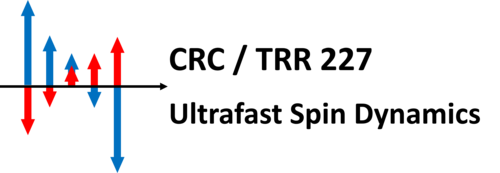The TRR 227 kindly invites you to a special TRR 227 Seminar.
Speaker: Prof. Dr Mathias Kläui, Institute of Physics, Johannes Gutenberg-Universität Mainz, Germany & Centre for Quantum Spintronics, Department of Physics, Norwegian University of Science and Technology, Trondheim, Norway
Title:
From spin-orbitronics to orbitronics: Efficient manipulation of topological spin structures for memory and unconventional computing
Abstract
Novel spintronic devices can play a role in the quest for GreenIT if they are stable and can transport and manipulate spin with low power. Devices have been proposed, where switching by energy-efficient approaches is used to manipulate topological spin structures [1,2].
We combine ultimate stability of topological states due to chiral interactions [3,4] with ultra-efficient manipulation using novel spin torques [3-5]. In particular orbital torques [6] increase the switching efficiency by more than a factor 10. We probe the materials dependence of the orbital current generation and conversion and show that the switching current density is strongly reduced compared to state-of-the-art spin-orbitronic devices.
We use skyrmion dynamics for non-conventional stochastic computing applications, where we developed skyrmion reshuffler devices [7] based on skyrmion diffusion, which also reveals the origin of skyrmion pinning [7]. Such diffusion can furthermore be used for Token-based Brownian Computing and Reservoir Computing [8].
We go beyond simple ferromagnets and study multilayers with antiferromagnetic coupling termed synthetic antiferromagnets. We find that the diffusion dynamics is drastically enhanced due to the topology and efficient dynamics can be induced by spin torques [9]. Finally, we find novel topological spin structures, such as bi-merons that are stabilized in synthetic antiferromagnets [10]
[1] G. Finocchio et al., J. Phys. D: Appl. Phys. 49, 423001 (2016)
[2] K. Everschor-Sitte et al., J. Appl. Phys. 124, 240901 (2018)
[3] S. Woo et al., Nat. Mater. 15, 501 (2016)
[4] K. Litzius et al., Nat. Phys. 13, 170 (2017)
[5] K. Litzius et al., Nat. Electron. 3, 30 (2020)
[6] S. Ding et al. Phys. Rev. Lett. 125, 177201 (2020); Phys. Rev. Lett. 128, 067201 (2022)
[7] J. Zázvorka et al., Nat. Nanotechnol. 14, 658 (2019); R. Gruber et al., Nat. Commun 13, 3144 (2022)
[8] K. Raab et al., Nat. Commun. 13, 6982 (2022); M. Brems et al., Appl. Phys. Lett. 119, 132405 (2021)
[9] T. Dohi et al., Nat. Commun. 14, 5424 (2023)
[10] M. Bhukta et al., arxiv:2303.14853 (Nat. Commun. in press 2024)
Time & Location
Jan 30, 2024 | 11:30 AM - 12:30 PM
Dahlem Center for Complex Quantum Systems (Room 1.4.07/08) - Physics Department - Freie Universität Berlin (Arnimallee 14, 14195 Berlin-Dahlem)
